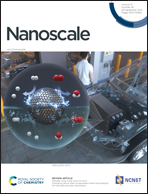Unexpected spontaneous dynamic oxygen migration on carbon nanotubes†
Abstract
Combining density functional theory (DFT) calculations and ab initio molecular dynamics (AIMD) simulations, we show that oxygen functional groups exhibit unexpected spontaneous dynamic behaviors on the interior surface of single-walled carbon nanotubes (SWCNTs). The hydroxyl and epoxy migrations are achieved by the C–O bond breaking/reforming reactions or the proton transfer reaction between the neighboring epoxy and hydroxyl groups. It is demonstrated that the spontaneous dynamic characteristic is attributed to the sharply reduced energy barrier less than or comparable to thermal fluctuations. We also observe a stable intermediate state with a dangling C–O bond, which permits the successive migration of the oxygen functional groups. However, on the exterior surface of SWCNTs, it is difficult for the oxygen groups to migrate spontaneously because there are relatively high energy barriers, and the dangling C–O bond prefers to transform into the more stable epoxy configuration. The spontaneous oxygen migration is further confirmed by the oxygen migration process using DFT calculations and AIMD simulations at room temperature. Our work provides a new understanding of the behavior of oxygen functional groups at interfaces and gives a potential route to design new carbon-based dynamic materials.



 Please wait while we load your content...
Please wait while we load your content...